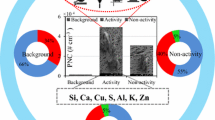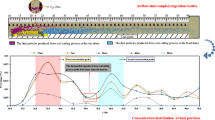Abstract
The granite manufacturing industry is an environment in which workers are exposed to high levels of ultrafine particles (UFPs) and crystalline silica dust. Overexposure to crystalline silica can cause health problems, in particular silicosis. This fatal lung disease persists worldwide despite knowledge of methods to control it. One way to partially overcome the problem of subjectivity and try to achieve objective experimental results is to run field crystalline silica dust surveys with trained human assessors (panelists). Such field inspections allow the determination of ambient air concentrations and are now seen as being a more convenient method for UFP impact assessment in the field. One drawback of field inspections is that they can get rather expensive, especially if the survey is conducted for an extended period of time involving a high number of panelists. This paper reviews the techniques that can be adopted to measure UFPs in the field and discusses how such techniques can be used as an alternative to, or in combination with, gas tracer dispersion methods for UFP impact assessment purposes, and how the results of field UFP measurements and model outputs can be related and compared to each other. Two simulation methods were used to study crystalline silica dust exposure during the granite polishing process (experimental and numerical). This study presents a method to measure UFP dispersion during granite manufacturing processes. A computational model was constructed to simulate the physical problem. The numerical study was carried out, on a simplified configuration (bench), modeling particle distribution near a rotating tool. CFD simulation results were compared to the experimental data using NaCl particles, a tracer gas (CO2), and UFP dispersion from granite polishing. The results showed good agreement between the two methods.











Similar content being viewed by others
References
Ahmad I, Khan MI, Patil G (2011) Nanotoxicity of occupational dust generated in granite stone saw mill. Nanoscience, Technology and Societal Implications (NSTSI), 2011 International Conference on:1–6
Boffetta P (2018) 1 - Classic epidemiology of lung cancer. In: Pass HI, Ball D, Scagliotti GV (eds) IASLC thoracic oncology. 2nd edn, pp 1-8.e3. http://www.sciencedirect.com/science/article/pii/B9780323523578000019
Colinet JF, Cecala AB, Chekan GJ, Organiscak JA, Wolfe AL (2010) Best practices for dust control in metal/nonmetal mining. NIOSH Information Circular 9521
Couch JR (2016) Evaluation of novel ventilation designs for increasing local exhaust ventilation performance in traditional settings and concrete dowel drilling. Doctoral dissertation. University of Michigan
Ding Y, Kuhlbusch TA, Van Tongeren M, Jiménez AS, Tuinman I, Chen R, Kaminski H (2017) Airborne engineered nanomaterials in the workplace—a review of release and worker exposure during nanomaterial production and handling processes. J Hazard Mater 322:17–28
Djebara A, Zedan Y, Kouam J, Songmene V (2013) The effect of the heat treatment on the dust emission during machining of an Al-7Si-Mg cast alloys. J Mater Eng Perform 22(12):3840–3853
Hinds WC (2012) Aerosol technology: properties, behavior, and measurement of airborne particles. Wiley, New York
Hoet P, Desvallées L, Lison D (2017) Do current OELs for silica protect from obstructive lung impairment? A critical review of epidemiological data. Crit Rev Toxicol 47(8):655–682
Johnson DL, Phillips ML, Qi C, Van AT, Hawley DA (2017) Experimental evaluation of respirable dust and crystalline silica controls during simulated performance of stone countertop fabrication tasks with powered hand tools. Ann Work Expo Health 61(6):711–723
Khettabi R, Nouioua M, Djebara A, Songmene V (2017) Effect of MQL and dry processes on the particle emission and part quality during milling of aluminum alloys. Int J Adv Manuf Technol 92(5–8):2593–2598
Kylafis GF (2016) The explosion and dispersion potential of engineered nanoparticles. Doctoral dissertation, University of Leeds
Methner MM, Page CEH (2017) Evaluation of exposure to crystalline silica, welding fume, and isocyanates during water heater manufacturing. NIOSH HHE report No. 2015-0076-3282 June 2017
Occupational Safety and Health Administration (2018). https://www.osha.gov/dsg/topics/silicacrystalline/samplinganalysis.html. Accessed 11 Nov 2018
Pacheco Y, Ponchon M, Lebecque S, Calender A, Bernaudin JF, Valeyre D, Renno T (2018) Granulomatous lung inflammation is nanoparticle type-dependent. Exp Lung Res 44(1):25–39
Phillips ML, Johnson DL, Johnson AC (2013) Determinants of respirable silica exposure in stone countertop fabrication: a preliminary study. J Occup Environ Hyg 10(7):368–373
ROHS (2017) Regulation respecting occupational health and safety. S-2.1, r. 13. http://legisquebec.gouv.qc.ca/en/showdoc/cr/S-2.1%2c%20r.%2013. Accessed 12 Dec 2017
Saidi MN, Songmene V, Kouam J, Bahloul A (2015) Experimental investigation on fine particle emission during granite polishing process. Int J Adv Manuf Technol 81(9–12):2109–2121
Steenland K, Ward E (2014) Silica: a lung carcinogen. CA Cancer J Clin 64(1):63–69
Tekade RK, Maheshwari R, Jain NK (2017) 9 - Toxicity of nanostructured biomaterials. In: Narayan R (ed) Nanobiomaterials. Woodhead Publishing. pp 31–256. https://www.sciencedirect.com/science/article/pii/B9780081007167000271
Verma DK, Vacek PM, Des Tombe K, Finkelstein M, Branch B, Gibbs GW, Graham WG (2011) Silica exposure assessment in a mortality study of Vermont granite workers. J Occup Environ Hyg 8(2):71–79
Villalpando F, Petro E,Reggio M, Bahloul A (2017) Assessment of a standard ventilation system for handling crystalline silica exposure in the countertop manufacturing industry: International Conference on Materials and Energy, Tianjin, China, 2107
Acknowledgements
This study is part of a larger research project on polishing granite (REF 2010-0047) funded by the Institut de Recherche Robert-Sauvé en Santé et Sécurité du Travail, IRSST (Montreal, Quebec, Canada) entitled “Characterization and Control of the Silica Dust Emitted During Dry and Wet Polishing Operations in the Granite and Other Quartz-Containing-Materials Processing Sector”. The authors also wish to thank A. Lacroix Granit (Saint-Boniface, Quebec, Canada) for donating the samples used in the experiments.
Author information
Authors and Affiliations
Corresponding author
Rights and permissions
About this article
Cite this article
Bahloul, A., Djebara, A., Saidi, M.N. et al. Computational and Experimental Analysis of Ultrafine Particle Dispersion During Granite Polishing. Aerosol Sci Eng 3, 21–31 (2019). https://doi.org/10.1007/s41810-018-00038-7
Received:
Revised:
Accepted:
Published:
Issue Date:
DOI: https://doi.org/10.1007/s41810-018-00038-7




